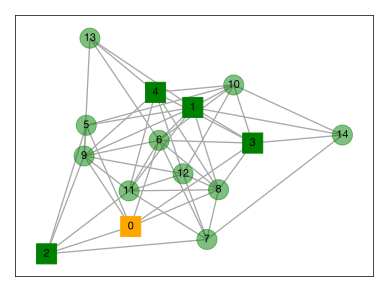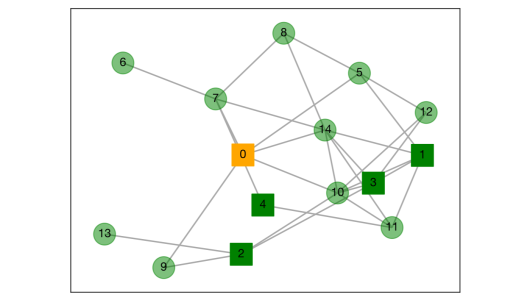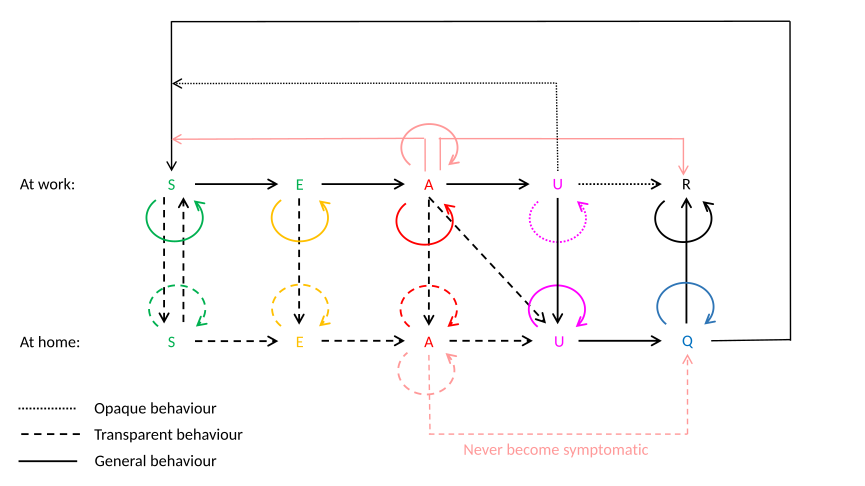Oxford Mathematician Arkady Wey discusses a stochastic agent-based model of the workplace, developed to explore the importance of compliance with test and trace programs following a pandemic lockdown.
Introduction
This study is inspired by the situation in the UK in the latter half of 2020. However, it is perhaps equally relevant now, as the nation attempts, once again, to restart the economy in the aftermath of a COVID-19 infection peak. One task that policy makers are currently faced with is to simultaneously permit the re-opening of workplaces whilst preventing a new surge in cases. There has been much recent evidence to suggest that rapid testing, contact tracing, and isolation of those in the contact group, is one of the most effective virus containment measures. Policy makers are interested in assessing how the degree of compliance in the population affects the success of this strategy.
In a workplace setting, one crucial measure of compliance is the transparency of the employee workforce. We consider a transparent workforce to be one made up of a large proportion of individuals that isolate at home upon receipt of a positive test, and notify other individuals, with whom they have been in contact, to do the same. A compliant employer might therefore be considered as one who encourages such transparent behaviour among employees.
In our study we assume a world in which rapid testing and results are available to anyone who is symptomatic. Routine contact tracing is used, where contacts of those testing positive are told to self-isolate. In this setting, we explore the effect of the presence of a proportion of non-compliant, or opaque, workers, who are not transparent about their infection-risk status, and do not go home when made aware that one of their colleagues has tested positive. Such opacity may be interpreted as a form of presenteeism, where workers continue to go to work despite possible infection or symptoms.
We pose the questions: is there an incentive for employees to engage with transparent behaviour? And, is there an incentive for employers to encourage it? That is, is it valuable to engage with test, trace, and isolate procedures, in order to halt virus spread while also maximizing productivity?
Model
To answer these questions, we present a discrete-time stochastic agent-based model for the workplace. The basic virus model we choose is a variation of the Kermack-McKendrick SEIR model.
In our model, nodes in a network are agents that represent individuals in the workplace. Each agent is in one of six viral states: Susceptible, Exposed, Infectious-Asymptomatic, Infectious-Symptomatic (Unwell), Quarantined, and Recovered. Agents are either Transparent, in which case they self-isolate at Home when they become unwell, and warn others to do the same, or they are Opaque, in which case they do neither, staying in Work. A diagram of the full set of possible state transitions is presented in Figure 1.
Figure 1: Sketch outlining the operation of the discrete-event model. Here S is susceptible, E is exposed (not yet infectious),
A is asymptomatic infectious, U is unwell infectious, Q is quarantined and R is recovered (and immune).
Lines/arrows give all possible transitions between states. More details here.
Edges in the network represent contacts between agents when they are in Work. The kinds of workplaces considered are those with relatively static interaction networks. An example of such a working environment is an office that is split into teams that are physically co-located, with a number of middle managers and service personnel who naturally migrate between several teams. We therefore make the simplifying assumption that the workplace can be represented by a fixed interaction network, some examples of which are shown in Figure 2.

Figure 2: An example of a randomly generated workplace contact network of 15 workers. 1/3 of the workforce is opaque
(solid square) and 2/3 is transparent (semi-transparent circle). One individual is infected with the virus and is therefore
in the Exposed state (orange node labelled 0), whereas all others are Susceptible (green nodes labelled 1-14). More details here.
Our workplace networks are dynamic, though, in the sense that an agent's contacts change as other agents isolate at Home and return to Work. Moreover, we do not consider a completely closed facility, since each agent is assumed to go about their daily business outside of the workplace, where there exists some base level of infection rate.
Results
The results of our simulations point to a double benefit of workforce transparency. That is, we find that a policy of high transparency is optimal for most workplace networks explored, not only for disease spread-prevention, which is perhaps unsurprising, but also for maximal productivity. This is despite the fact that a policy of transparency involves sending a worker home as soon as they are in contact with an infectious colleague. This result holds true in cases where working from home does not significantly diminish the productivity of each individual worker.
Additionally, our results suggest an inverse proportionality between workforce opacity and the average contact degree of the workplace network. That is, the greater the average number of connections to each worker in the workplace, the more transparent the workforce must be to avoid the disease taking hold. This suggests that contact-limiting measures should always be taken alongside transparency policies, since disease spread will not be sufficiently limited in highly connected workplace networks, even by a maximally transparent workforce.
Our study highlights the need for policies that encourage compliance in the workplace population. We outline guiding principles for these policies, such as the no detriment principle, whereby workplace populations engender a culture in which there is no perceived detriment to a worker who is transparent. One associated policy intervention might be the decision to remunerate workers if they are required to self-isolate and to penalize workers if they are found to be at work while knowingly infectious. Another might be the introduction of governmental statutory sickpay for all workers, irrespective of their contractual status, from day one of self-isolation.
Overall, we find that compliant behaviour in the workforce population is mutually beneficial for employees and the employer, and might be necessary for the safe re-opening of workplaces in the post-peak phase of pandemics such as COVID-19.



